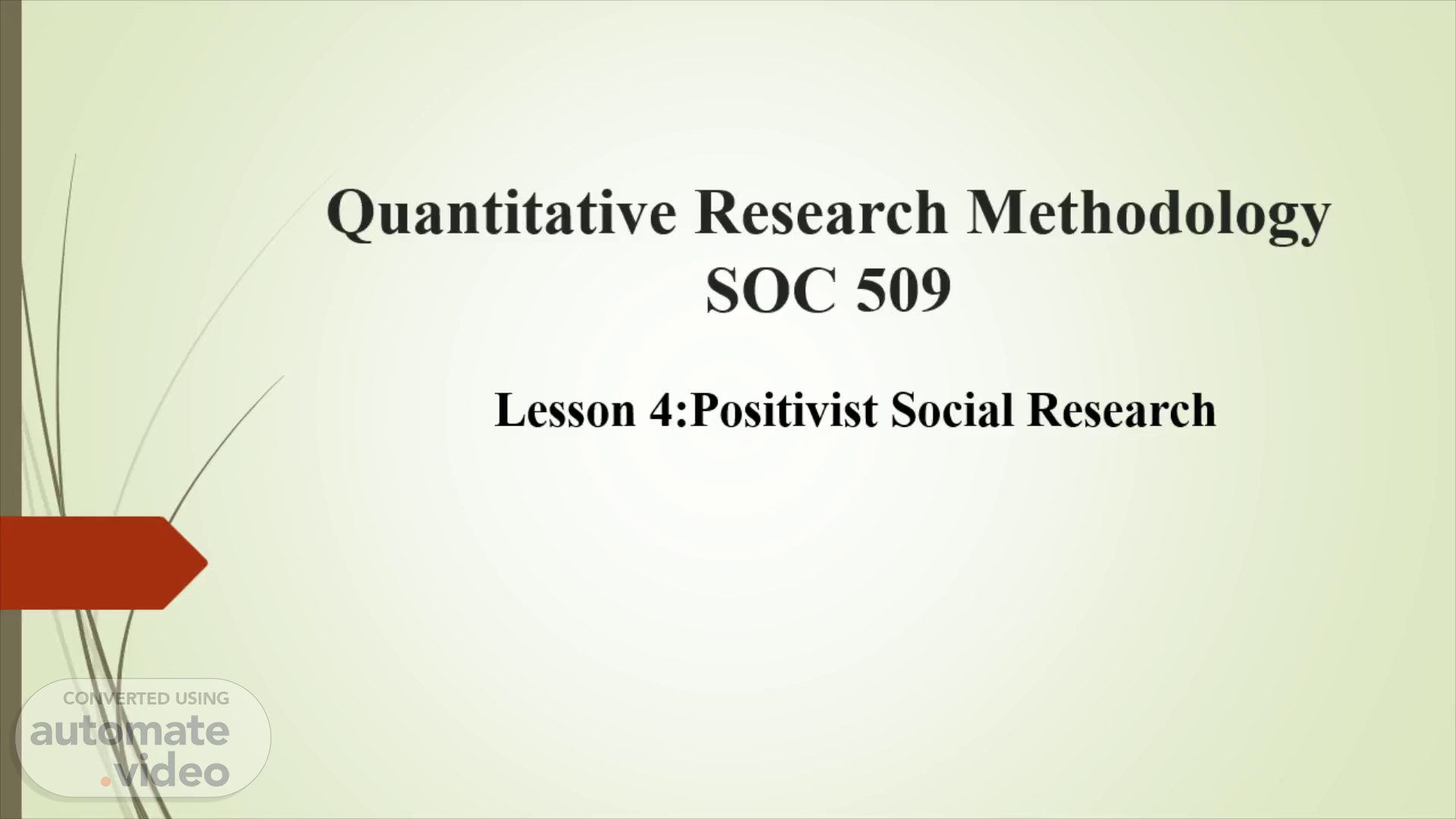
Quantitative Research Methodology SOC 509
Scene 1 (0s)
Quantitative Research Methodology SOC 509. Lesson 4: Positivist Social Research.
Scene 2 (28s)
History of Positivist Social Research. Positivism believes the basis for knowledge and thought should depend on the scientific method. It was introduced by Auguste Comte, a French philosopher who coined the term “positivism.”.
Scene 3 (1m 14s)
The positivist does not derive conclusions from a subjective approach and does not let feelings and emotions cloud his judgment because these things are in the person’s consciousness. The consciousness, Comte inferred, cannot be objectively observed. Positivism has been a dominant paradigm in social science, especially as practiced in the United States since 1945 . Positivism was the dominant epistemological paradigm in social science from the 1930s through to the 1960s. Its core argument being that the social world exists externally to the researcher, and that its properties can be measured directly through observation..
Scene 4 (2m 28s)
Anthropology and history are the least positivist fields and economics and experimental psychology the most positivist with political science and sociology somewhat mixed. Several paradigms compete in sociology, but it “has been Paradigm A general organizing framework for theory and research that includes basic assumptions, key issues, models of quality research, and methods for seeking answers. Predominantly positivist since 1945, aside from a brief period of epistemological turmoil . . .” (Steinmetz, 2005a:25)..
Scene 5 (3m 47s)
Introduction. Positivism tries to uncover the one truth about how things. It is defined as a system recognizing only that which can be scientifically verified or logically proved, and therefore rejecting metaphysics and theism’ (Oxford, 1989: pp. 385-386) Positivism argues that reality consists of what is available to the senses – that is, what can be seen, smelt, touched, etc. Inquiry should be based upon scientific observation and empirical inquiry. The natural and human sciences share common logical and methodological principles, dealing with facts and not with values..
Scene 6 (4m 52s)
A structured method, combining logical deduction with precise empirical (well known) observations (of the behavior of individuals). To open up and confirm causal relationships that are generally valid with a known probability and which can therefore be used for prediction. The purpose of science is to uncover the truth & make it to be able to control and predict. Humans are expected to be rational. Objectivity and precision is important. Therefore measurement and measures, tools and procedures are very important. Because reality is stable and truths are generally valid..
Scene 7 (6m 39s)
Main Assumptions of positivism. Positivism is a philosophy that holds that empirical evidence obtained through the senses is the only firm foundation for knowledge. Further , it insists that valid knowledge can only be assumed if all observers come up with essentially the same description of a thing. Last , it requires that these descriptions be uniform across all researchers or observers, which leads to the requirement that measurement is the royal road to knowledge..
Scene 8 (7m 54s)
Thus, positivism leads to the following four sets of assumptions: Ontological assumptions (nature of reality): There is one defined reality, fixed, measurable, and observable. Epistemological assumptions (knowledge): Genuine knowledge is objective and quantifiable. The goal of science is to test and expand theory. Axiological assumptions (role of values): Objectivity is good, and subjectivity is inherently misleading..
Scene 9 (9m 40s)
Methodological assumptions (research strategies): Using quantitative research methods such as experiments, quasi-experiments, exploratory and analytical models, case studies, and so on—which require objective measurement and analysis—is the only acceptable method to generate valid knowledge . As should be obvious, such assumptions lead to quantitative studies, which rely on objective measurement of observable phenomena. That which cannot be measured cannot be reliably known..
Scene 10 (11m 15s)
Positivistic Research Study Example : We take the example of published their article, " Consumer Acceptance and Use of Information Technology: Extending the Unified Theory of Acceptance and Use of Technology," examining consumer acceptance and use of information technology..
Scene 11 (11m 41s)
The author/researcher made the following assumptions: Ontological assumption: Consumer acceptance and use of information technology can be observed and measured. There is one defined reality for these constructs and if measured, will be readily visible to all who observe it. Epistemological assumption: The acquisition of knowledge of consumer acceptance and use of information technology is an objective process, one that can be measured, and that measured and objective report is reliable and useful knowledge. Axiological assumption: The measurements for consumer acceptance and information technology will objectively inform the theory of acceptance and use of technology, which is a valuable to understand ..
Scene 12 (13m 37s)
Methodological assumption: Quantitative design—A new survey instrument was adapted from the Unified Theory of Acceptance and Use of Technology (UTAUT)—a four input construct model of performance expectancy, effort expectancy, social influence and facilitating conditions which influence behavioral intentions of use ( Vankatesh et al., 2003). Additional existing scales were also adapted to measure variables of hedonic motivation, price value, and habit with moderating variables of age, gender and experience. After a pilot study, a two-stage online survey was conducted to explain behavioral intention and the subsequent mobile use behavior. The measurement and structural models were tested using Partial Least Squares to create UTAUT2.
Scene 13 (17m 32s)
References. Venkatesh , V., Thong, J. Y., & Xu , X. (2012). Consumer acceptance and use of information technology: Extending the theory of acceptance and use of technology. MIS Quarterly , 36 , 157–178. Venkatesh , V., Morris, M. G., Davis, G. B., & Davis, F. D. (2003) User acceptance of information technology: Toward a unified view. MIS Quarterly, 27 , 425–478. Creswell , J. W., & Creswell, J. D. (2017). Research design: Qualitative, quantitative, and mixed methods approaches. Sage publications. Neumann, L. (2014). Social Research Methods: Qualitative and Quantitative Approaches. Seven Edition. Pearson..
Scene 14 (18m 6s)
Feel free to ask question if you have any confusion.
Scene 15 (18m 15s)
Simple Thank You Slide PowerPoint Designs | Slidebazaar.